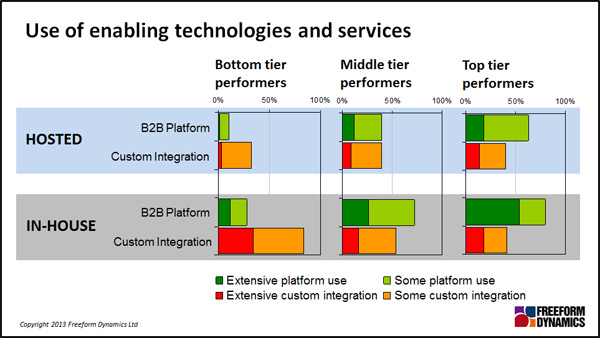By Dale Vile
In a previous article we highlighted the fact that many organisations could do a lot better when it comes to electronic integration with their customers and suppliers. One of the problems we highlighted was the fragmented and often disjointed internal information landscape that adds to the complexity of any initiative to improve things. The call to action was to include consideration of B2B integration requirements when scoping information management initiatives aimed at creating a more coherent and integrated environment.
While getting to grips with this information challenge is clearly important when looking to optimise supply and demand chain activity, putting the right kind of technology and/or cloud services in place can also pay dividends, and our research provides some very strong evidence of this.
During a study in which feedback was gathered from just over two hundred organisations across the UK and Netherlands, we asked a range of questions which allowed us to group respondents based on their level of B2B integration capability. This took into account the depth and breadth of B2B automation, together with more empirical indicators of performance such as the speed and efficiency of partner on-boarding, how well routine transactions are handled, and the level of flexibility in place to deal with changing requirements over time.
Looking across the three groups we ended up with, some striking differences can be seen in the kinds of enabling technology they use. The worst performers are heavily dependent on custom integration solutions running in-house, with minimal use of hosted services. Top performers, on the other hand, are much more likely to be taking advantage of B2B integration platforms, either running in-house or delivered as a hosted service (see figure below).

The focus on B2B platforms among top performers makes perfect sense. The kind of middleware we are referring to here provides a coherent software environment in which the data models, transformations, policies and workflows needed to facilitate an automated trading approach can be created and managed in a much more open and flexible manner.
B2B platform solutions also tend to provide a good set of APIs and connectors that streamline the job of establishing electronic hook-ups when new trading partners are being ‘on-boarded’. They also generally allow you to present a web interface to smaller customers and suppliers who may not have either the capability or know-how to put system level integration in place. The value of this is not to be underestimated, as smaller partners can be critical to the business, yet often collectively represent a considerable administration burden due to a heavy reliance on paper, email and manual processing. Allowing them to interact via a browser, with documents and transactions being captured directly into your systems, can dramatically cut overheads and reduce errors, as well as providing more timely and accurate operational visibility.
This last point brings us to the other big benefit of taking a more coherent platform-based approach. With all B2B activity essentially being routed through the same layer of middleware, you get a much more holistic view of what’s going on. It’s therefore no coincidence that our top tier performers cite significant benefits in the area of reporting, analytics and performance management.
But what about the greater use of hosted services by top performers – what’s behind that?
Well this doesn’t take too much working out when you consider the nature of the activity we have been discussing. It’s heavily dependent on reliable and secure connectivity across organisational boundaries, and an ability to manage sensitive information from multiple parties without getting things mixed up. These are requirements that are obviously very close to the heart of any hosted or cloud service provider, so B2B integration is arguably one of the most natural cloud applications you can get.
But like all good solutions, B2B platforms, whether implemented in-house or via a hosted service, are not magic bullets. While adopting a platform-based approach is clearly aligned with better overall performance as the research shows, the Devil is in the detail when it comes to implementation.
It’s important, for example, to make sure that any internal data integrity and systems integration challenges are identified and, wherever possible, dealt with before you embark on a B2B platform implementation project. Otherwise you’ll end up with scope creep and budget overruns as you take time out to tackle underlying problems while progress is held up on the job at hand. Some vendors and services providers can help with this, but not all are comfortable working in the internal systems domain, so you need to do your due diligence before engaging suppliers.
If you are interested in seeing more of the insights that came out of the research, on this or any other aspect of this highly important area, we would encourage you to take a look at the full study report, which can be downloaded free of charge from here.
CLICK HERE TO VIEW ORIGINAL PUBLISHED ON
